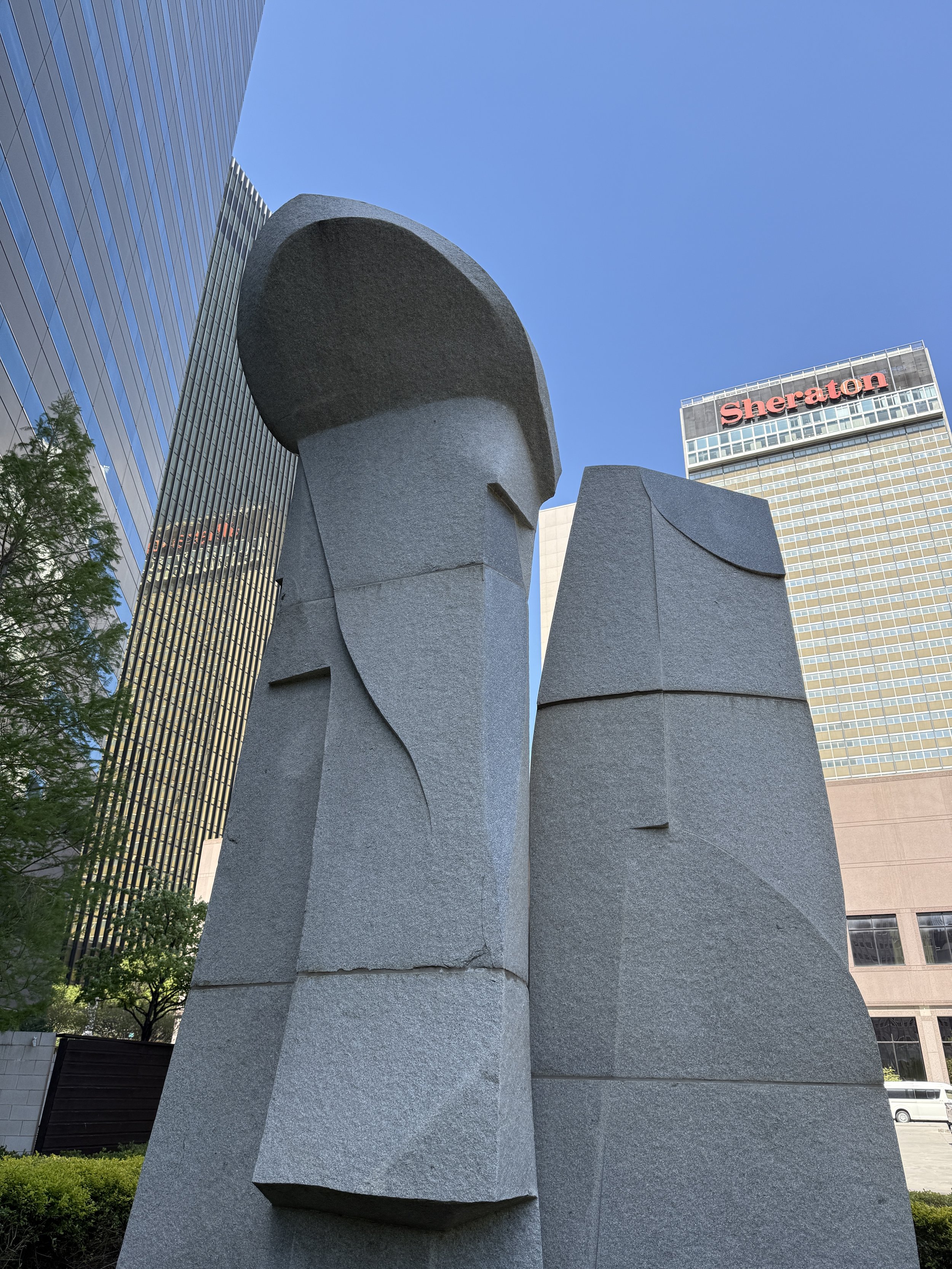45 yrs ago… Hadzi’s commission “Bishops Triad” dedicated in Dallas
45 years ago in May 1980, Dimitri Hadzi’s “Bishops Triad” was dedicated on St. Paul Street plaza in Dallas, TX. On this occasion, we revisit a feature in the Dallas Times Herald which announced and discussed this major commission.
Dallas Times Herald, Friday, May 23, 1980
Hadzi piece dedicated at One Dallas Centre
By Janet Kutner / Art Editor of The News
A 20-foot-high granite sculpture by Dimitri Hadzi, the New York artist whose public works also grace Lincoln Center and Boston's John F. Kennedy Government Center, was dedicated on the St. Paul Street Plaza of One Dallas Centre Thursday.
Commissioned by One Dallas Centre owner-developer Vincent Carrozza, “Bishops Triad” consists of three columns that range in height from 16 to 20 feet and weigh more than 45 tons.
The gray Triad provides a striking complement to the glass and aluminum building, which was designed by Henry N. Cobb of New York's IM Pei & Partners.
Archival photo of Hadzi’s “Bishops Triad,” 1980:
THE DALLAS situation represents only one of many times Hadzi, who was born in New York City of Greek-American parents, has worked closely with an architect in the conception of a piece. His Kennedy Center sculpture, rather baroque and active compared with the Dallas work, involved close communication with Walter Gropius. Hadzi worked with Max Abramovitz of Harrison & Abramovitz in New York in planning the sculpture for Lincoln Center's Philharmonic Hall (now Avery Fisher Hall [named David Geffen Hall in 2015]). He will work with Abramovitz again soon in conceiving a piece for a public site near Toledo, Ill. The Hadzi sculpture at Minneapolis' Federal Reserve Bank involved close communication with Gunnar Birkerts, the architect who also designed Houston's Contemporary Arts Museum.
The abstract Triad's gesture toward One Dallas Centre at the top of a column recalls the more obviously regenerative aspect of an earlier Hadzi bronze that belongs to the Dallas Museum of Fine Arts. It was given originally to the Dallas Museum for Contemporary Arts, which merged in the early 1960s with DMFA. Hadzi said that, 1959 piece, which is titled Primavera (Spring), represents an almost conscious reaction on his part to the depressing aspect of work he did only shortly before as a memorial to Auschwitz.
Although a number of Hadzi's earlier sculptures related to battles and armor, the most consistent references in his work have been to mythological or classical themes.
Both the verticality of the One Dallas Centre sculpture and the solidity of Its forms recall the timeless remnants of earlier civilizations, such as those at Mycenae and Stonehenge.
Watch the 360 walk around video (posted April 2025):
“I CONSIDER most of my sculptures to be based on natural forms," Hadzi said shortly after his piece was dedicated on the plaza of One Dallas Centre, "But the most recent works are more geological than figurative in nature."
The way the Bishops Triad relates to the space it inhabits - a ledge that is set out from One Dallas Centre and permits one to view it from all sides with ease — reflects conscious decisions on Hadzi's part.
"The main problem was scale, and for that reason about half a year ago I made a wooden mock-up of the building," Hadzi said. "It was then I realized the sculpture needed to be larger by about three feet."
We originally considered bronze for the piece, but granite won out," Hadzi said, describing the material as Concord stone from New Hampshire. "I think the decision was correct because the granite goes well with the building and the sky."
Certainly at a bright time of day (the piece was dedicated at noon), the way the sun highlights the flecks in the stone adds considerable vitality to the work.
The tripodal form of the Dallas piece also reiterates a characteristic common to other Hadzi sculptures.
"I often prefer the tripod, which was typically used for Chinese ceremonial objects and is also the symbol of stability," Hadzi said. "Three feet are far more stable than four, and the Thermopylae piece I did for Gropius was also a tripod.
"But I think of this sculpture as very hopeful," he said, alluding to its thrust toward the skies.
ALTHOUGH MORE specific references might be made to religious overtones, Hadzi said he prefers the term "mystery" to "religion."
The Dallas sculpture, which reveals Hadzi's affinity with the abstract modern art movements such as cubism, was conceived originally as a drawing and then grew in five stages from early models made in wax, plaster, bronze and finally granite.
Hadzi was born in 1921 and studied at Cooper Union as well as at the Brooklyn Museum of Art School in New York. From 1950 to 1951 he studied as a Fulbright Fellow at the Athens Polytechnic and at the Museo Artistico Industriale in Rome, where he eventually lived for 25 years.
Hadzi's work is included in the collections of the Museum of Modern Art and the Whitney Museum of American Art in New York City and is owned by the Hirshhorn Museum in Washington.
While Hadzi devotes considerable time to commissions for large public sculptures, he continues to work on a much smaller scale.


